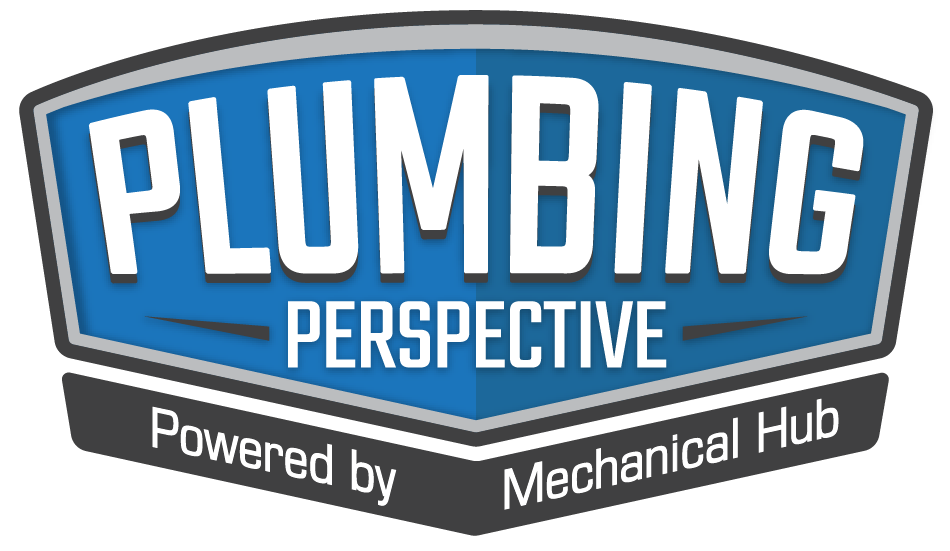Single fitting incorporates two flow paths that keep fresh water close to each fixture. WICHITA, Kan. – Viega introduces double drop elbow fittings that maintain water quality by reducing stagnation. The elbows are designed to keep fresh water close to each fixture. The new, flow-through style fittings, designed with threaded fixture connections and integrated mounting Read more
Whats Next
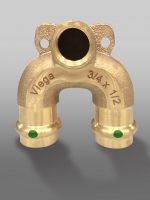
Single fitting incorporates two flow paths that keep fresh water close to each fixture.
WICHITA, Kan. – Viega introduces double drop elbow fittings that maintain water quality by reducing stagnation. The elbows are designed to keep fresh water close to each fixture.
The new, flow-through style fittings, designed with threaded fixture connections and integrated mounting brackets, are used in series or ring installations and can be used in hot or cold water systems. Flow-through fittings allow water distribution systems to be designed in new ways to reduce stagnation with configurations that allow the use of a single fixture to generate flow through many fixtures up to the point of connection. This type of system also minimizes dead legs between tees and wall penetrations.
“The new double drop elbows provide a connection and mounting similar to those supplied by a drop ninety in a conventional installation,” said Derek Bower, product director, metal systems, Viega. “Viega’s new double drop elbows allow for smarter installation designs, reduced stagnation and increased flow through seldom-used pipes and fixtures.”
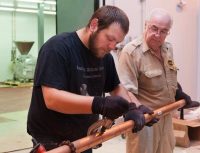
Connoisseurs of capsaicin, that fiery oil in chili peppers, are a rare breed. Hot-headed food lovers know that truly spicy food is a bit hard to come by, often produced in small, custom ordered batches. Sausage artisan, Jim Cefelli, says his company may produce just 10 pounds of their Triple-X Spicy sausage in a week Read more
Connoisseurs of capsaicin, that fiery oil in chili peppers, are a rare breed. Hot-headed food lovers know that truly spicy food is a bit hard to come by, often produced in small, custom ordered batches.
Sausage artisan, Jim Cefelli, says his company may produce just 10 pounds of their Triple-X Spicy sausage in a week, even though the facility produces nearly 20,000 pounds of sausage on an average day. Cifelli & Sons has shipped gourmet meat — most the non-spicy variety — throughout the East Coast, and as far as Bermuda, since 1974.
“When my father went into business, he was producing 16,000 pounds of sausage a week,” said Jim Cifelli, who runs the company with his brother, Anthony. “We now process about 90,000 pounds a week, and we’ve outgrown our 3,000-square-foot facility.”

(L-R) Al Puccio, with Focus Sales, worked With Gene Celler, owner of Heritage Plumbing & Heating during the design process.
The Cifelli brothers have been seeking a larger building for a few years. A bigger facility with more walk-in cooler space would allow them to further expand their operation and expedite production. Last year, when a conveniently-located commercial lease opened up, they decided to retrofit the 13,000-sq.-ft. building to meet their needs.
“The basics were here,” said Cifelli. “It’s the right size, has loading docks and is easy to get in and out of with a box truck. What it lacked was a processing room, freezer space, and the robust plumbing needed for meat processing.” Luckily, the property owner was happy to facilitate the extensive renovations.
During the planning phase, Cifelli sought the expertise of George Sansiveri & Associates, a plant engineering firm that specializes in FDA and USDA inspected facilities. A key facet of Sansiveri’s design was a hot water plant to supply ample volume throughout the day. Work on the facility began in March of 2015.
“We use a lot of hot water,” explained Cifelli. “Before lunch break, the processing room is hosed down with scalding water, and at the end of the day, we do a full cleanout of all six machines. At that point, the USDA inspector comes and must approve the state of the processing room.”
The building’s owner introduced Cifelli to Gene Celler, owner of Heritage Plumbing and Heating, Inc. The five-person company was hired to install the new hot water plant in a tight mechanical space adjacent to the processing room. Celler took the design to his Bradford White wholesaler, Steve Morris at the Aaron & Company’s Freehold, NJ branch and to Focus Sales, in Middlesex, NJ, to select the best equipment for the application.

To ensure a robust and dependable supply of hot water, the installer used two Bradford White Brute Series volume water heaters and a large Bradford White storage tank.
“The four wash-down hoses can dump as much as 10 GPM each,” said Al Puccio, manufacturer’s rep at Focus Sales. “And it needs to be much hotter than at a residence.”
Heavy duty plumbing
Because a failure to produce hot water could shut the plant down for days, Cifelli was adamant that the system be as close to fail-safe as possible. This was reflected in the design. Two light commercial volume water heaters were used instead of one larger unit. The original design specified a pair of 85% efficient volume water heaters, stacked one above the other to save space. It also called for a large storage tank.
“Gene brought the design to me with a few ideas to improve it,” said Puccio. “He needed water heaters that would fit easily into a small mechanical room, and we both saw the advantage of using condensing units as opposed to atmospheric.”
 After a discussion with the engineer, Puccio selected two, 285 MBH Bradford White Brute Series volume water heaters. These heat a 415 gallon Bradford White storage tank, which is made by a subsidiary company, Niles Steel Tank.
After a discussion with the engineer, Puccio selected two, 285 MBH Bradford White Brute Series volume water heaters. These heat a 415 gallon Bradford White storage tank, which is made by a subsidiary company, Niles Steel Tank.
“Aside from higher efficiency and the ability to modulate firing rate, we wanted to use the Brute Series units because of their flexibility of installation,” said Puccio. “The top connections allowed Gene to position the units side-by-side to save space, without sacrificing room to service them.”
Hot water on demand
“A one-and-a-half-inch water line from the street enters the top of the big storage tank,” said Celler, who started Heritage in 1985. The water heaters draw and return water from near the bottom of the tank. This helps us de-stratify its water volume.”
A pair of valves and temperature gauge on each wash-down hose bib can be used to dial in the exact temperature needed, but the storage tank is set at 150°F. An aquastat will fire the lead water heater, followed by the second unit two minutes later if needed.
Heritage installed a one-and-a-quarter-inch hot water recirculation line to ensure fast delivery to all points throughout the building, including restrooms and break area. As stainless steel Taco 007 pump is used for the loop.
“I took this design to Focus Sales because I wanted to install Bradford White water heaters,” said Cellar. “I’ve been using their products for many years, and the tech support and warranty are great.”
According to Celler, the condensing equipment was more expensive, but it will pay for itself quickly. Without the material and labor to install the rack to stack the atmospheric boilers, it was a difference of a few thousand dollars. He calculated that the new, 95% efficient volume water heaters will save Cifelli around $1,000 per year.
“The owner of the building didn’t want us to penetrate the roof to vent the water heaters,” said Celler. “Being able to use a PVC side-wall vent was a big plus.”
Back in business
In addition to the hot water system, Heritage remolded the bathrooms, installed pneumatic lines and six air stations, ran gas pipe for a new generator, put in floor drains and assembled a 300-gallon grease trap.
“About half our work is commercial, but this was the first time I’ve done a meat processing plant,” said Celler. “It came with its own set of challenges. Everything had be to spec, down to the very last stainless steel screw. Sansiveri’s design was fantastic. Everything fit like a glove.”
Heritage Plumbing and Heating was finished in August. The Cifelli Brothers continued to oversee the finishing touches in the cooling spaces and processing rooms while also keeping their original plant in full swing.
“I hope to be producing here by Labor Day,” said Cifelli. “We currently offer 10 varieties of sausage, and this facility will allow us to add a poultry sausage. We’ll also be able to add equipment that’ll remove some of the heavy physical lifting that’s currently a big part of the work at the old plant.”
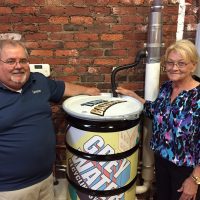
While visiting the Plumbing Museum, Watertown, Mass., this past week, Mechanical Hub learned about the museum’s newest, working rainwater harvesting exhibit coming soon. “We have a lot of local vo-tech students come through here and they definitely will be interested in the new display. This will be another educational opportunity offered by the Plumbing Museum,” Read more
While visiting the Plumbing Museum, Watertown, Mass., this past week, Mechanical Hub learned about the museum’s newest, working rainwater harvesting exhibit coming soon. “We have a lot of local vo-tech students come through here and they definitely will be interested in the new display. This will be another educational opportunity offered by the Plumbing Museum,” says Linda Veiking, event coordinator.
Concurrently, the Plumbing Museum Board of Directors held its annual meeting to discuss new opportunities and projects, one of which is the water reclamationsystem display, which is in collaboration with the Artists for Humanity.
The Plumbing Museum opened in Worcester, MA in 1979. The Manoog family hosted the Plumbing Museum until 2008. Mr. Manoog’s father, Charles, began collecting antique commodes, claw-foot tubs, ornate sinks and other plumbing items beginning in the 1950s. A museum for these items was established by son Russell in 1979. In its Worcester location, the American Sanitary Plumbing Museum had hosted curious visitors.
In 2007, J.C. Cannistraro was presented with a unique opportunity. Through the company’s association with the Plumbing Heating and Cooling Contractors (PHCC) of Greater Boston, word had traveled that Russell and BJ Manoog, curators of the American Sanitary & Plumbing Museum in Worcester, were looking for someone to continue operation of the museum after their retirement.
The building that is now home to The Plumbing Museum was once the property of brothers Abraham and Edward Howard who supplied their thriving Watertown, Massachusetts ice business with ice, wood and coal from their Charles River storage yard and ice house. The brothers’ father, skilled merchant and Civil War veteran Frederick Howard, started in the ice trade in 1842. Following in their father’s footsteps, the brothers grew the business and it became the Metropolitan Ice Company around 1925. With progress in home heating and refrigeration the ice trade became obsolete. The property surrounding the ice house was sold, and industrial growth changed the landscape.
In 1984, J.C. Cannistraro, Inc., under the direction of John Cannistraro, Sr., purchased the ice house from the Jac-Pac Company, a frozen meat distributor, and relocated his company from a small garage on Pleasant Street in Watertown. During the next twenty years, numerous additions and developments were made resulting in the large complex that is now the J.C. Cannistraro, LLC corporate offices and prefabrication facility.
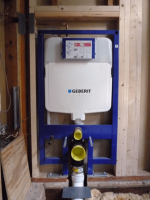
Accommodating an oversize cast-iron bathtub during a bathroom remodel was a key challenge for Barbara Kochie of Barbara Kochie Design, LLC. Kochie’s clients, owners of a 1920s bungalow in Middletown, New Jersey, wished to keep the tub for budgetary and aesthetic reasons. The small size of the space – roughly 7.5 ft. x 8.5 ft Read more
Accommodating an oversize cast-iron bathtub during a bathroom remodel was a key challenge for Barbara Kochie of Barbara Kochie Design, LLC. Kochie’s clients, owners of a 1920s bungalow in Middletown, New Jersey, wished to keep the tub for budgetary and aesthetic reasons. The small size of the space – roughly 7.5 ft. x 8.5 ft. – made this very difficult. The flexibility of the Geberit in-wall system helped Kochie meet the challenge.
Bathroom’s space-consuming and outdated shower, toilet, and baseboard heating had to make way for a modern, aging-in-place bathroom.
Hide the tank, hang the toilet.
“Our clients traveled extensively throughout Europe and saw many recessed tanks and wall-hung heating systems in their travels. To meet their requirements, we removed the old toilet and the baseboard heater, opening up floor space, freeing room for the wall-hung toilet, and providing ample space for the walk-in shower. Our client wanted easy access and drastically reduced cleaning time. They got both with the Geberit in-wall system for wall-hung toilets.” says Kochie. In fact, Kochie says her client’s cleaning time was reduced by 75%.

The Geberit in-wall system’s installation flexibility allowed re-positioning of the toilet, opening up space for the remodel.
Geberit Duofix carriers are easy to install in either 2˝ x 4˝ or 2˝ x 6˝ wood or metal frame construction. To accommodate the in-wall system, the installer simply creates an opening in the studs, 23-1/4˝ wide for a 2˝ x 4˝ installation or 19-3/4˝ wide for a 2˝ x 6˝ installation. The adjustable-height carrier allows positioning the toilet 15˝ to 19˝ off the floor to meet ADA requirements or personal preference.

Repositioning the toilet with a Geberit in-wall system allowed the homeowner to modernize the bathroom for aging-in-place.
The toilet’s installation height of 15˝ (ADA required height), along with grab bars and a walk-in shower, met the client’s requirements. Another benefit: the Geberit flush plate in polished chrome not only enhances the contemporary design, it saves water. The Geberit dual-flush system lets the user choose between a standard flush (1.6 gpf/6 lpf) for solids and a low-volume flush (0.8 gpf/3 lpf) for liquids, saving up to 5,000 gallons of water per year.
More space? Yes, please.
Re-positioning the toilet allowed Kochie to make space for the vanity and shower and to compensate for the existing bathtub. Moving the toilet to an interior wall would also eliminate the need to insulate the tank against freezing. The installation flexibility of the Geberit in-wall system was a proven asset in the bathroom design. The toilet installation allowed the tank to go into the 4˝ wall and miss the existing vent pipe, saving the homeowners the additional cost of moving the pipe.
Kochie maximized the space by removing the old cabinets. She also installed a custom vanity and countertop, a combination wall-hung heater and towel warmer, and a glass-enclosed walk-in shower. Floor-to-ceiling porcelain tile throughout, including the tub surround, unifies the space.
RIDGID® has awarded four scholarships through the Educational Foundation of the Plumbing-Heating-Cooling Contractors – National Association (PHCC) to students enrolled in plumbing-heating-cooling apprentice programs. PHCC administers the scholarship program, which is designed to attract new talent essential to the future of the plumbing and HVACR industry, and is also responsible for selecting the award winners Read more
RIDGID® has awarded four scholarships through the Educational Foundation of the Plumbing-Heating-Cooling Contractors – National Association (PHCC) to students enrolled in plumbing-heating-cooling apprentice programs. PHCC administers the scholarship program, which is designed to attract new talent essential to the future of the plumbing and HVACR industry, and is also responsible for selecting the award winners. Scholarship recipients will receive up to $1,000 in tuition assistance and $1,500 in RIDGID tools. RIDGID has proudly supported this scholarship program since 2011.
“Contractors are desperately seeking skilled workers to hire,” said Christopher Burton, global director of brand management for RIDGID. “These scholarships help to get skilled workers trained and prepared, with quality tools in hand, to fill those open positions in our industry.”
The 2015 scholarship recipients are:
- Brian Cates of Sacramento, Calif. is working for PHCC member Calidad Plumbing in Folsom and is enrolled as a plumbing apprentice at the PHCC GSA Apprentice Program.
-
Andrew Kappelmeier of Landenberg, Pa. is pursuing a degree in HVAC Technology at Pennsylvania College of Technology.
- Gary Quintana of El Cajon, Calif. is working for PHCC member Drum Plumbing in San Diego and is enrolled as a plumbing apprentice at the PHCC Academy of San Diego.
- Brandon Ramos, Jr. of Spring Valley, CA is working for PHCC member BP Plumbing in San Diego and is enrolled as a plumbing apprentice at the PHCC Academy of San Diego.
For additional information about RIDGID, please visit www.RIDGID.com, call toll-free: 1-800-769-7743, or contact RIDGID, 400 Clark St., Elyria, Ohio 44035 U.S.A.
About PHCC Educational Foundation®
PHCC Educational Foundation, a partnership of contractors, manufacturers, and wholesalers, was founded in 1987. Its purpose is to serve the plumbing-heating-cooling industry by providing educational tools and preparing contractors and their employees to meet the challenges of a constantly changing marketplace. For more information contact a member of the Foundation staff at (800) 533-7694 or visit phccfoundation.org.
About RIDGID®
RIDGID®, a business unit of Emerson®, headquartered in Elyria, Ohio, is a leading manufacturer of innovative tools and equipment for the professional trades. The company’s broad offering of more than 300 types of tools serves the demanding needs of customers in the commercial, industrial and energy markets in over 140 countries. For more information, visit RIDGID.com or follow us on Facebook, LinkedIn, Twitter and other popular social media sites.
